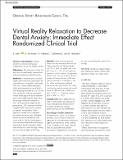Files in this item
Virtual reality relaxation to decrease dental anxiety : immediate effect randomized clinical trial
Item metadata
| dc.contributor.author | Lahti, S | |
| dc.contributor.author | Suominen, A | |
| dc.contributor.author | Freeman, R | |
| dc.contributor.author | Lähteenoja, T | |
| dc.contributor.author | Humphris, G. | |
| dc.date.accessioned | 2020-11-02T16:30:02Z | |
| dc.date.available | 2020-11-02T16:30:02Z | |
| dc.date.issued | 2020-10-01 | |
| dc.identifier | 265421481 | |
| dc.identifier | de80402b-6423-4c8a-b55a-4691d41961de | |
| dc.identifier | 85078153325 | |
| dc.identifier | 000508863100001 | |
| dc.identifier | 31962052 | |
| dc.identifier.citation | Lahti , S , Suominen , A , Freeman , R , Lähteenoja , T & Humphris , G 2020 , ' Virtual reality relaxation to decrease dental anxiety : immediate effect randomized clinical trial ' , JDR Clinical & Translational Research , vol. 5 , no. 4 , pp. 312-318 . https://doi.org/10.1177/2380084420901679 | en |
| dc.identifier.issn | 2380-0844 | |
| dc.identifier.other | ORCID: /0000-0002-4601-8834/work/68281414 | |
| dc.identifier.uri | https://hdl.handle.net/10023/20884 | |
| dc.description.abstract | Introduction: Dental anxiety is common and causes symptomatic use of oral health services. Objectives: The aim was to study if a short-term virtual reality intervention reduced preoperative dental anxiety. Methods: A randomized controlled single-center trial was conducted with 2 parallel arms in a public oral health care unit: virtual reality relaxation (VRR) and treatment as usual (TAU). The VRR group received a 1- to 3.5-min 360° immersion video of a peaceful virtual landscape with audio features and sound supporting the experience. TAU groups remained seated for 3 min. Of the powered sample of 280 participants, 255 consented and had complete data. Total and secondary sex-specific mixed effects linear regression models were completed for posttest dental anxiety (Modified Dental Anxiety Scale [MDAS] total score) and its 2 factors (anticipatory and treatment-related dental anxiety) adjusted for baseline (pretest) MDAS total and factor scores and age, taking into account the effect of blocking. Results: Total and anticipatory dental anxiety decreased more in the VRR group than the TAU group (β = −0.75, P < .001, for MDAS total score; β = −0.43, P < .001, for anticipatory anxiety score) in patients of a primary dental care clinic. In women, dental anxiety decreased more in VRR than TAU for total MDAS score (β = −1.08, P < .001) and treatment-related dental anxiety (β = −0.597, P = .011). Anticipatory dental anxiety decreased more in VRR than TAU in both men (β = −0.217, P < .026) and women (β = −0.498, P < .001). Conclusion: Short application of VRR is both feasible and effective to reduce preoperative dental anxiety in public dental care settings (ClinicalTrials.gov NCT03993080). Knowledge Transfer Statement: Dental anxiety, which is a common problem, can be reduced with short application of virtual reality relaxation applied preoperatively in the waiting room. Findings of this study indicate that it is a feasible and effective procedure to help patients with dental anxiety in normal public dental care settings. | |
| dc.format.extent | 7 | |
| dc.format.extent | 350582 | |
| dc.language.iso | eng | |
| dc.relation.ispartof | JDR Clinical & Translational Research | en |
| dc.subject | Dental fear | en |
| dc.subject | Clinical studies/trials | en |
| dc.subject | Relaxation technics | en |
| dc.subject | Virtual reality immersion | en |
| dc.subject | Dental care | en |
| dc.subject | Public sector | en |
| dc.subject | RK Dentistry | en |
| dc.subject | RM Therapeutics. Pharmacology | en |
| dc.subject | T Technology | en |
| dc.subject | NDAS | en |
| dc.subject.lcc | RK | en |
| dc.subject.lcc | RM | en |
| dc.subject.lcc | T | en |
| dc.title | Virtual reality relaxation to decrease dental anxiety : immediate effect randomized clinical trial | en |
| dc.type | Journal article | en |
| dc.contributor.institution | University of St Andrews. Sir James Mackenzie Institute for Early Diagnosis | en |
| dc.contributor.institution | University of St Andrews. Population and Behavioural Science Division | en |
| dc.contributor.institution | University of St Andrews. WHO Collaborating Centre for International Child & Adolescent Health Policy | en |
| dc.contributor.institution | University of St Andrews. Health Psychology | en |
| dc.contributor.institution | University of St Andrews. St Andrews Sustainability Institute | en |
| dc.contributor.institution | University of St Andrews. School of Medicine | en |
| dc.identifier.doi | https://doi.org/10.1177/2380084420901679 | |
| dc.description.status | Peer reviewed | en |
This item appears in the following Collection(s)
Items in the St Andrews Research Repository are protected by copyright, with all rights reserved, unless otherwise indicated.

